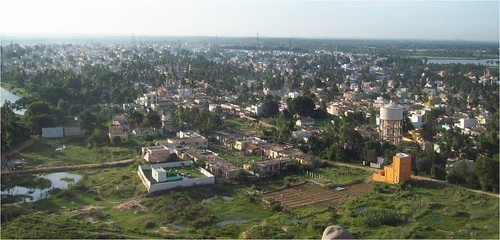/topics/geogenic-contamination
Geogenic Contamination
Influence of anthropogenic contamination on fluoride concentration in groundwater: A study of Mulbagal town, Kolar district, Karnataka
Posted on 15 Feb, 2013 04:53 PMGroundwater contamination is a serious, but relatively ignored issue in the country. This contamination occurs in either through geogenic or anthropogenic means. Fluoride contamination is one such example of geogenic contamination that is widely found in the Kolar district of Karnataka. However, the fluoride levels in the town of Mulbagal are lower than those in the surroundings. Earlier, a study was conducted on the impact of pit toilets on the groundwater in the area. The present paper investigates the presence of any link between these two phenomena.
Assessment of exposure, intake and toxicity of fluoride from groundwater sources in Unnao district of Uttar Pradesh
Posted on 28 Jan, 2013 01:40 PMFluoride is one of the most commonly found elements in the earth’s crust. It is naturally found d in water and helps in healthy tooth development and cavity prevention. However its high concentration in water can be harmful to human health. The amount of Fluoride (F) occurring naturally in groundwater is governed principally by climate, composition of the host rock, and hydrogeology. As per the World Health Organization and Indian Council of Medical Research the permissible limit to fluoride in drinking water is 1.5mg/L. Anything more than this value can cause fluorosis (dental and skeletal), which can affect the bones and teeth. In the backdrop of this aspect of water quality, this paper in RASĀYAN Journal of Chemistry, tries to assess the exposure to fluoride through drinking water consumption and to elucidate fluoride endemic areas through mapping in Unnao district of Uttar Pradesh.
Water, sanitation and health situation in select villages of Nadia district, West Bengal
Posted on 13 Jan, 2013 03:45 PMGuest post: Veena Khanduri, India Water Partnership
The Gangetic river basin in Eastern India receives heavy monsoon rainfall, much higher than the rest of India. Nonetheless, the region suffers from both the problem of year round water availability as well as poor quality of drinking water. Due to excessive exploitation, the groundwater aquifers in the region have been depleting alarmingly, surface water is highly limited & poorly maintained and consequently cannot count up as a major source of safe drinking water.
Drought mitigation measures through climate adaptation for securing agricultural livelihoods in Uttar Pradesh
Posted on 13 Jan, 2013 02:43 PMProlonged and recurrent drought, being experienced in India and various parts of south Asia, is the manifestation of climate change, partly caused by human interventions. Drought has been one of the primary reasons for widespread poverty and environmental degradation including deteriorating water quality and water security. The world has been more drought-prone during the past 25 years and the vulnerability of tropical countries to drought is likely to increase (Inter-governmental Panel on Climate Change, 2007).
Effect of drinking arsenic-contaminated water in children- Article in Indian Journal of Public Health
Posted on 09 Jan, 2013 10:44 PMThis paper in Indian Journal of Public Health sheds light on the specific impact of arsenic on health of children based on the review of literature on the subject. The effects of chronic arsenic toxicity under the following aspects:
- Psychological
- Skin abnormalities
- Lung diseases
- Defect in intellectual function
- Genetic issues
Impact of pit-toilet leachate on groundwater chemistry and role of vadose zone in removal of nitrate and E. coli pollutants in Kolar District, Karnataka, India
Posted on 04 Jan, 2013 02:00 PMGiven the many problems associated with flush toilets and the sewerage system, pit toilets offer a viable solution in India. However, the use of soakpits raises the question of groundwater contamination. This paper assesses the impact of pit toilet leachate on groundwater quality in Mulbagal town (pop ~ 60,000) in Karnataka relies on pit toilets, and uses groundwater for drinking.
Briefing papers on ‘Jal kothis’, ‘Matka filter’, 'Dug wells' and ‘Phayedemand shauchalaya’: Local innovative solutions in flood prone Bihar by Megh Pyne Abhiyan (2011)
Posted on 29 Dec, 2012 03:14 PMThe briefing papers include the following:

"Arghyam prepares Water Quality Management (WQM) framework for rural areas" - Ministry of Drinking Water and Sanitation releases its first e-newsletter on water and sanitation in India (December 2012)
Posted on 24 Dec, 2012 08:51 PMThe newsletter refers to the nationwide campaign carried out by Arghyam, with the aim of creating awareness on water quality issues with a specific focus on fluoride contamination in groundwater sources, by engaging students from across the country in a water quality testing, analysis, and reporting.
In the newsletter, the spotlight is turned on:
Highlights from the 10-year water policy research programme of the International Water Management Institute and the Sir Ratan Tata Trust discussed at the IWMI - TATA Annual Partners' Meet at Anand, between 28-30 November, 2012
Posted on 05 Dec, 2012 02:06 PMIWMI-Tata water policy research programme is a collaborative initiative between the International Water Management Institute (IWMI) and the Sir Ratan Tata Trust (SRTT).
Drinking water treatment technologies - A handbook by National Environmental Engineering Research Institute & Ministry of Drinking Water and Sanitation
Posted on 30 Nov, 2012 10:22 PMThis handbook prepared by National Environmental Engineering Research Institute has eight chapters:
Chapter 1 introduces the objectives and approaches adopted to prepare the handbook.





